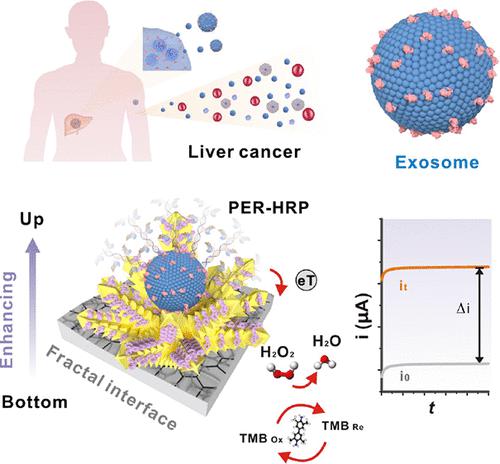Our official English website, www.x-mol.net, welcomes your
feedback! (Note: you will need to create a separate account there.)
Bottom-Up Signal Boosting with Fractal Nanostructuring and Primer Exchange Reaction for Ultrasensitive Detection of Cancerous Exosomes
ACS Sensors ( IF 8.2 ) Pub Date : 2023-02-28 , DOI: 10.1021/acssensors.2c02819 Minmin Huang 1 , Yuanhang Xiang 1 , Yu Chen 1 , Hao Lu 1 , Hui Zhang 1 , Fengfei Liu 2 , Xiaoling Qin 1 , Xiaojie Qin 1 , Xinchun Li 1 , Fan Yang 1
ACS Sensors ( IF 8.2 ) Pub Date : 2023-02-28 , DOI: 10.1021/acssensors.2c02819 Minmin Huang 1 , Yuanhang Xiang 1 , Yu Chen 1 , Hao Lu 1 , Hui Zhang 1 , Fengfei Liu 2 , Xiaoling Qin 1 , Xiaojie Qin 1 , Xinchun Li 1 , Fan Yang 1
Affiliation

|
Exosomes are emerging as promising biomarkers for cancer diagnosis, yet sensitive and accurate quantification of tumor-derived exosomes remains a challenge. Here, we report an ultrasensitive and specific exosome sensor (NPExo) that initially leverages hierarchical nanostructuring array and primer exchange reaction (PER) for quantitation of cancerous exosomes. This NPExo uses a high-curvature nanostructuring array (bottom) fabricated by single-step electrodeposition to enhance capturing of the target exosomes. The immuno-captured exosome thus provides abundant membrane sites to insert numerous cholesterol-DNA probes with a density much higher than that by immune pairing, which further allows PER-based DNA extension to assemble enzyme concatemers (up) for signal amplification. Such a bottom-up signal-boosting design imparts NPExo with ultrahigh sensitivity up to 75 particles/mL (i.e., <1 exosome per 10 μL) and a broad dynamic range spanning 6 orders of magnitude. Furthermore, our sensor allows monitoring subtle exosomal phenotypic transition and shows high accuracy in discrimination of liver cancer patients from healthy donors via blood samples, suggesting the great potential of NPExo as a promising tool in clinical diagnostics.
中文翻译:

分形纳米结构和引物交换反应自下而上的信号增强用于癌性外泌体的超灵敏检测
外泌体正在成为有前途的癌症诊断生物标志物,但对肿瘤来源的外泌体进行灵敏和准确的定量仍然是一个挑战。在这里,我们报告了一种超灵敏和特异性外泌体传感器 (NPExo),它最初利用分层纳米结构阵列和引物交换反应 (PER) 来定量癌性外泌体。该 NPExo 使用通过单步电沉积制造的高曲率纳米结构阵列(底部)来增强目标外泌体的捕获。因此,免疫捕获的外泌体提供了丰富的膜位点,可以插入许多密度远高于免疫配对的胆固醇-DNA 探针,这进一步允许基于 PER 的 DNA 延伸来组装酶多联体(向上)以进行信号放大。这种自下而上的信号增强设计赋予 NPExo 高达 75 个颗粒/mL 的超高灵敏度(即每 10 μL <1 个外泌体)和跨越 6 个数量级的宽动态范围。此外,我们的传感器允许监测细微的外泌体表型转变,并显示出通过血液样本区分肝癌患者与健康供体的高精度,表明 NPExo 作为临床诊断工具的巨大潜力。
更新日期:2023-02-28
中文翻译:

分形纳米结构和引物交换反应自下而上的信号增强用于癌性外泌体的超灵敏检测
外泌体正在成为有前途的癌症诊断生物标志物,但对肿瘤来源的外泌体进行灵敏和准确的定量仍然是一个挑战。在这里,我们报告了一种超灵敏和特异性外泌体传感器 (NPExo),它最初利用分层纳米结构阵列和引物交换反应 (PER) 来定量癌性外泌体。该 NPExo 使用通过单步电沉积制造的高曲率纳米结构阵列(底部)来增强目标外泌体的捕获。因此,免疫捕获的外泌体提供了丰富的膜位点,可以插入许多密度远高于免疫配对的胆固醇-DNA 探针,这进一步允许基于 PER 的 DNA 延伸来组装酶多联体(向上)以进行信号放大。这种自下而上的信号增强设计赋予 NPExo 高达 75 个颗粒/mL 的超高灵敏度(即每 10 μL <1 个外泌体)和跨越 6 个数量级的宽动态范围。此外,我们的传感器允许监测细微的外泌体表型转变,并显示出通过血液样本区分肝癌患者与健康供体的高精度,表明 NPExo 作为临床诊断工具的巨大潜力。











































 京公网安备 11010802027423号
京公网安备 11010802027423号